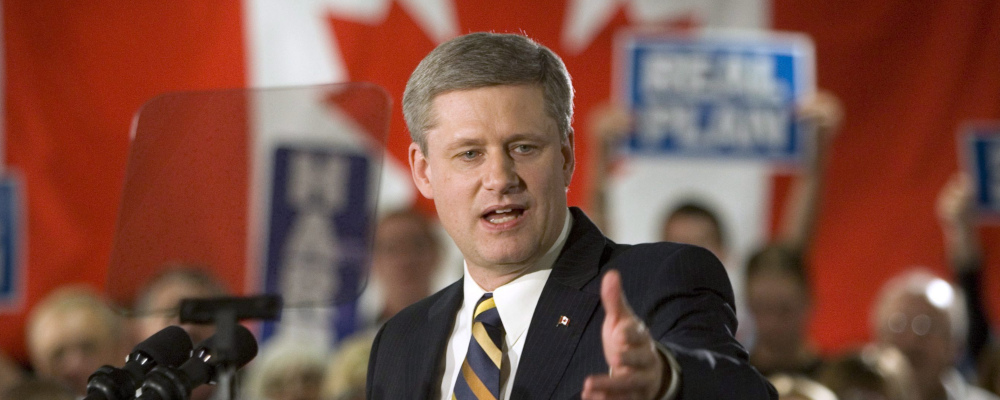Starting this week, The Hub is publishing essays that reflect some of the different intellectual and political persuasions that comprise modern Canadian conservatism. The goal of the ongoing series is to establish something of a generally-acceptable Canadian conservative taxonomy as well as to understand the points of convergence and divergence across the various conservative factions.
One is struck in reading these thoughtful commentaries by the extent to which the different perspectives that make up Canadian conservatism aren’t seemingly aligned on big political questions about culture, economics, and the proper purpose of politics.
Modern libertarianism’s live-and-let-live philosophy, for instance, can conflict with social conservatism’s conception of a virtuous society. Similarly the techno-optimism of today’s Silicon Valley-inspired conservatism runs into conflict with traditional conservatism’s skepticism of technology and progress which may be best reflected in Russell Kirk’s derisive description of automobiles as “mechanical Jacobins.” There are also subtle yet notable regional variations in Canada including Atlantic Canadian communitarianism, Quebec cultural nationalism, and historic Prairie populism.
The question is: what holds these different factions together as an intellectual movement as well as a matter of electoral politics?
The latter may actually be a more straightforward answer. Although these different factions may have divergent political priorities or points of ideological emphasis, they tend to share a common opposition to Trudeaupian liberalism which combines an aversion to markets with an outright hostility to traditionalist values. Political oppositionalism shouldn’t, in other words, be underestimated as a unifying force in a world of negative polarization.
Libertarians and social conservatives may not agree, for instance, on whether the federal government should subsidize student summer jobs, but they’ll invariably agree that if it does, it shouldn’t impose a progressive litmus test to determine eligibility. That the Liberal Party has moved to the Left on both economics and culture over the past decade only reinforces the coalitional case for different conservative factions to work together as an electoral strategy.
This point is worth emphasizing: notwithstanding the media’s focus on the prospects of the Conservative Party’s disunity, there’s little evidence to think that’s a serious risk. The combination of generational change within the Conservative ranks and Pierre Poilievre’s own popularity with the party’s electoral base as well as these new and emerging center-right voters actually portends a near-term future of even greater Conservative Party unity.
Yet these political calculations are partly contingent on Canada’s first-past-the-post electoral system. Its winner-take-all dynamic preferences large brokerage parties which therefore incentivizes ideological factions to overcome their differences and instead focus on their common electoral objectives.
The case for the Conservative Party itself can come to rely too much on these arguments. Conservative author and pundit, Tasha Kheirriddin, for instance, recently argued in an episode of Hub Dialogues that “fracturing the [conservative] vote [led to] the Liberals in power for 13 years … That’s usually what’s happened in the history of Canadian politics when seeing a new centre-right or new right-wing party emerge.”
The problem with this line of argument is it’s so highly contingent that it lacks an affirmative case separate and apart from our particular institutional arrangements. In a different electoral system, including, for instance, proportional representation, the wholly political case for a conservative coalition would diminish. Under that scenario, these different factions could ostensibly splinter into separate political parties that run under their own partisan banners and then come together post-election through a transactional parliamentary arrangement.
Such a counterfactual should prompt serious philosophical questions about whether these different conservative factions actually hold together as an intellectual movement or merely coalesce together as a utilitarian electoral coalition that shares mutual ideological and political opponents rather than common goals and values. Put differently: Is modern Canadian conservatism a marriage of shared values or a marriage of convenience? I happen to think it’s the former.
It’s worth an aside here to recognize that the “fusionist” project which first found expression at National Review magazine in the 1950s and sought to build a principled-based argument for a pro-liberty and pro-traditionalist coalition was not solely rooted in political arguments. Its originators such as Frank Meyer and Bill Buckley sought to establish a philosophical case rooted in the idea that freedom and virtue ought to be understood as two sides of the conservative coin.
There’s no doubt that there are members of today’s conservative factions who couldn’t find themselves in an intellectual fusionism. Their relationship to other conservatives is merely a matter of political calculation including the power of negative partisanship. But as someone who has spent most of his adult life in these circles, my informed hunch is that they represent a minority. Most conservatives, in my experience, see themselves as part of a marriage rooted in a mutuality of ideas and values.
Canadian conservatism has always involved a unique North American mix of different ideological viewpoints, intellectual persuasions, and temperamental dispositions. From its root, it has reflected a combination of small “l” liberalism’s focus on liberty and a small “c” conservatism’s emphasis on tradition as well as something of a small “p” populism that drew on the continent’s frontier mentality. The relative weight of these different intellectual and political impulses has ebbed and flowed at various times over our history but they all can lay claim to being part of the Canadian conservative tradition.
As McGill University PhD candidate and Hub contributor Ben Woodfinden and I write in an essay for a forthcoming compilation on Canadian political thought, Sir John A. Macdonald should be viewed as the progenitor of this amalgam of liberalism and conservatism:
“Macdonaldian ideology, then, can be best described as a ‘liberal-conservatism.’ It was a synthesis of the two intellectual traditions: he personified a particularistic amalgam of the old world and the new world. Burkean traditionalism and Hamiltonian dynamism both ran through the Old Chieftain.”
There’s a strong case, in fact, that the Macdonaldian model, which may seem somewhat contingent and even contradictory but ultimately reflects an ongoing dialogue between liberal progress and conservative tradition, remains the default intellectual basis for an ecumenical form of Canadian conservatism.
It’s perhaps best characterized in what I’ve previously written with Ken Boessenkool as “ordered liberty” – which involves an emphasis on liberty, personal freedom and individual autonomy that’s rooted in an understanding of institutions, traditions and norms which impose non-coercive yet powerful constraints on base human instincts and channel them in constructive directions.
The idea here is an inherently fusionist one that draws on some basic yet enduring insights about human experience and human nature. Freedom depends on a set of underlying values and cultural norms to thrive and even sustain itself. Virtue similarly requires freedom – it cannot ultimately flourish in a climate of coercion.
The best contemporary expression of this understanding of Canadian conservatism is probably found in former Prime Minister Stephen Harper’s 2003 speech to Civitas in which he talked about the different conservative factions and how they hold together as a coherent intellectual movement. His key insight was that these different ideological and political impulses should be viewed less as neat-and-tidy coalitional factions and instead be understood as running through the heads and hearts of most conservatives themselves. As he explained:
“The truth is that strong economic and social conservatives are more often than not the same people, and not without reason. Except at the extremes of libertarianism and theocracy, the philosophical fusion has become deep and wide-spread. Social conservatives more often than not demand the government stop intervening in individual decisions, just as classical liberals often point to the religious roots of their focus on the individual…[Similarly] private enterprise and trade, as Adam Smith pointed out, can turn individual selfishness into useful social outcomes. In fact, the founder of classical liberal economics came to his theories as much by his study of moral philosophy as anything else.”
Harper’s description of Canadian conservatism still resonates with me and generally reflects most of the conservatives that I’ve encountered. While individuals will invariably have different policy preferences and come down on different issues in divergent ways based on prudential or temperamental considerations, most conservatives broadly share a commitment to liberty and an appreciation for tradition.
On one hand, it reminds me of Bill Buckley’s adage: a real conservative need not be religious but cannot be hostile to religion. At the same time, a reactionary, illiberal conservatism would be mostly ahistorical in the Canadian context and outside the norm of the Canadian conservative tradition. As I’ve previously written for The Hub, Canadian conservatism is fundamentally about conserving the country’s liberal ideas, institutions, and values.
At this level of abstraction, there bound to be considerable agreement among different conservatives. It’s the application of first principles and political choices about when to emphasize liberty over tradition or vice versa that’s bound to produce some tensions. The sweet spot is when you can draw on both. Harper-era pro-family policies like the Universal Child Care Benefit and Registered Disability Savings Plans are good examples. They combined a preference for individual choice with a conservative understanding of the family as the primary social institution.
Which brings us to the current Conservative Party leadership race. Most polls and pundits anticipate that Pierre Poilievre will be the winner. He’s talked a lot about freedom in the campaign as a unifying idea for the full spectrum of conservatives. I think he’s broadly correct, especially in the context of pandemic restrictions, cancel culture, and so on, that an emphasis on freedom will no doubt find salience across the different conservative factions. It should help to buttress their coalitional instinct in the lead up to the next federal election.
But as his post-leadership message evolves, Poilievre should aim to bring greater expression to broader conservative notions of faith, family, and tradition in the name of what former Prime Minister Harper called a “broad coalition of conservative ideas.” That would be in keeping with the Canadian conservative tradition of ordered liberty and help to answer the all-important question: freedom for what?
Recommended for You

Laura David: Red pill, blue pill: Google has made its opening salvo in the AI-news war. What’s Canadian media’s next move?

The Notebook by Theo Argitis: Mark Carney’s first major tests

The Weekly Wrap: Trudeau left Canada in terrible fiscal shape—and now Carney’s on clean-up duty

Ben Woodfinden: Lament for an ‘elbows up’ nation




